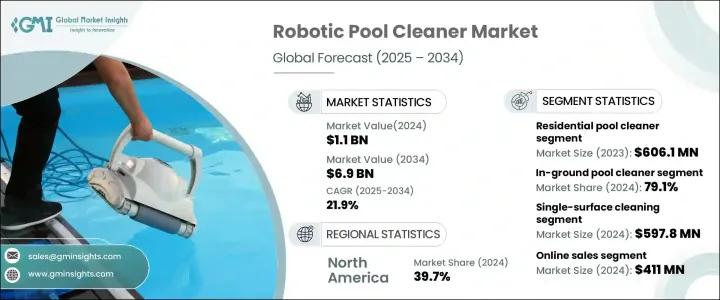
|
시장보고서
상품코드
1699259
세계의 수영장 로봇 청소기 시장 - 기회, 성장 촉진요인, 산업 동향 분석, 예측(2025-2034년)Robotic Pool Cleaner Market Opportunity, Growth Drivers, Industry Trend Analysis, and Forecast 2025-2034 |
||||||
세계의 수영장 로봇 청소기 시장은 2024년 11억 달러에 달했고, 2025년부터 2034년까지 연평균 복합 성장률(CAGR) 21.9%로 확대될 것으로 예측됩니다.
시장 성장의 원동력이 되고 있는 것은 북미와 유럽에서의 풀 설치 증가와 로봇 기술의 급속한 진보입니다.

AI를 활용한 수영장 로봇 청소기는 최적의 청소 경로를 매핑하고 장애물을 탐색하며 풀 레이아웃에 맞게 종합적인 범위를 조정하도록 설계되었습니다. 지속가능한 솔루션에 대한 선호도가 증가함에 따라 수요가 가속화되고 있습니다.
| 시장 범위 | |
|---|---|
| 시작 연도 | 2024년 |
| 예측 연도 | 2025-2034년 |
| 시작 금액 | 11억 달러 |
| 예측 금액 | 69억 달러 |
| CAGR | 21.9% |
시장은 제품 유형별로 구분되며, 주택용 수영장 로봇 청소기가 2023년에 6억 610만 달러로 리드하고 있습니다. 한편, 업무용 수영장 로봇 청소기는 2022년에 2억 3,240만 달러로 평가되었습니다. 업무용 수영장 로봇 청소기는 내구성과 효율성을 높이고 대형 풀의 철저한 청소를 실현하면서 운영 비용을 절감합니다.
풀 유형으로 시장은 지상과 지상 수영장 로봇 청소기로 분류됩니다. 이러한 클리너는 설치와 유지보수가 쉽고, 깊고 일관된 청소가 필요한 풀을 위한 주요 솔루션이 되었습니다.
수영장 로봇 청소기는 세척 유형에 따라 추가로 분류되며 단면 세척과 다면 세척이 있습니다. 단면 세척은 2024년 5억 9,780만 달러의 최고 수익을 창출했으며, 파이버 글라스와 콘크리트와 같은 균일한 표면을 가진 수영장에 대응합니다. 그러나 시장은 다양한 수영장의 질감에 의해 적응하는 다표면 클리너로 전환하고 있어 그에 따라 수요가 증가하고 있습니다.
유통 채널 분석에서는 온라인 판매의 우위성이 강조되어 2024년에는 4억 1,100만 달러를 차지하고 있습니다. E-Commerce 플랫폼은 원활한 구매 체험, 경쟁력 있는 가격 설정, 현관 앞까지 배달을 제공해, 시장 확대에 있어 중요한 판매를 하고 있습니다.
연결성에 따라 시장은 유선과 무선 수영장 로봇 청소기로 나뉘어져 있습니다.
지역별로는 북미가 2024년에 39.7%의 최대 시장 점유율을 차지했으며, 높은 가처분 소득과 풀 소유의 강한 동향이 견인했습니다.
목차
제1장 조사 방법과 조사 범위
- 시장 범위와 정의
- 기본 추정과 계산
- 예측 계산
- 데이터 소스
제2장 주요 요약
제3장 업계 인사이트
- 생태계 분석
- 밸류체인에 영향을 주는 요인
- 이익률 분석
- 파괴
- 미래의 전망
- 제조업체
- 유통업체
- 공급자의 상황
- 이익률 분석
- 주요 뉴스
- 규제 상황
- 영향요인
- 성장 촉진요인
- 첨단 기술, AI, 센서의 통합이 진행
- 에너지 효율이 높고 환경 친화적인 수영장 세척 솔루션
- 스마트 홈 솔루션에 대한 소비자 수요 증가
- 에너지 효율과 환경 지속가능성 향상
- 업계의 잠재적 위험 및 과제
- 첨단 로봇 풀 청소기의 높은 초기 비용
- 불규칙한 풀의 형태나 표면에 대한 적응성에 한계
- 성장 촉진요인
- 성장 가능성 분석
- Porter's Five Forces 분석
- PESTEL 분석
제4장 경쟁 구도
- 소개
- 기업 점유율 분석
- 경쟁 포지셔닝 매트릭스
- 전략 전망 매트릭스
제5장 시장 추계 및 예측 : 제품 유형별, 2021-2034년
- 주요 동향
- 주택용 풀 클리너
- 업무용 풀 클리너
- 기타
제6장 시장 추계 및 예측 : 풀 유형별, 2021-2034년
- 주요 동향
- 인그라운드 풀 클리너
- 지상 풀 클리너
제7장 시장 추계 및 예측 : 세정 유형별, 2021-2034년
- 주요 동향
- 단면 세정
- 다면 세정
제8장 시장추계 및 예측 : 연결성별, 2021-2034년
- 주요 동향
- 유선
- 무선
제9장 시장 추계 및 예측 : 유통 채널별, 2021-2034년
- 주요 동향
- 온라인 판매
- 홈센터
- 수영장 용품점
- 직접 판매
제10장 시장 추계 및 예측 : 지역별, 2021-2034년
- 주요 동향
- 북미
- 미국
- 캐나다
- 유럽
- 영국
- 독일
- 프랑스
- 이탈리아
- 스페인
- 러시아
- 아시아태평양
- 중국
- 인도
- 일본
- 한국
- 호주
- 라틴아메리카
- 브라질
- 멕시코
- 중동 및 아프리카
- 남아프리카
- 사우디아라비아
- 아랍에미리트(UAE)
제11장 기업 프로파일
- Aiper
- AQUATRON ROBOTIC TECHNOLOGY LTD.
- Hayward Industries, Inc
- iRobot Corporation
- Kreepy Krauly
- Mariner 3S AG
- Maytronics
- Ofuzzi
- Pentair
- Polaris
- Pool Corporation
- Smorobot
- ZODIAC
The Global Robotic Pool Cleaner Market reached USD 1.1 billion in 2024 and is projected to expand at a CAGR of 21.9% from 2025 to 2034. The market growth is fueled by increasing swimming pool installations across North America and Europe and rapid advancements in robotics technology. Innovations in artificial intelligence and automation are making pool cleaning more efficient, reducing energy consumption, and minimizing chemical usage.

AI-driven robotic pool cleaners are designed to map optimal cleaning routes, navigate obstacles, and adjust to the pool's layout for comprehensive coverage. These smart features enhance cleaning efficiency and extend equipment longevity. The growing preference for sustainable solutions is also accelerating demand, as robotic pool cleaners consume less electricity than traditional cleaning methods, resulting in cost savings and a smaller environmental footprint. As consumers seek hassle-free pool maintenance, the industry is witnessing significant growth, particularly in residential and commercial applications.
| Market Scope | |
|---|---|
| Start Year | 2024 |
| Forecast Year | 2025-2034 |
| Start Value | $1.1 Billion |
| Forecast Value | $6.9 Billion |
| CAGR | 21.9% |
The market is segmented based on product type, with residential robotic pool cleaners leading at USD 606.1 million in 2023. These automated devices utilize AI-based navigation, suction, and pressure-driven mechanisms to clean pool floors, walls, and waterlines efficiently. Their ability to reduce manual effort and energy usage has made them a preferred choice for homeowners. On the other hand, the commercial pool cleaner segment was valued at USD 232.4 million in 2022. Commercial-grade robotic pool cleaners offer enhanced durability and efficiency, reducing operational costs while delivering thorough cleaning for large swimming pools.
In terms of pool type, the market is categorized into in-ground and above-ground robotic pool cleaners. The in-ground segment accounted for 79.1% of the global market in 2024, reflecting its widespread adoption. These cleaners are easy to install and maintain, making them the go-to solution for pools that require deep and consistent cleaning. Above-ground pool cleaners are also gaining traction, providing effective solutions for pools that are installed above ground level.
Robotic pool cleaners are further classified based on cleaning type, with single-surface and multi-surface cleaning variants. Single-surface cleaners generated the highest revenue of USD 597.8 million in 2024, catering to pools with uniform surfaces such as fiberglass or concrete. However, the market is shifting toward multi-surface cleaners, which are more adaptable to various pool textures, thereby increasing their demand.
The distribution channel analysis highlights the dominance of online sales, which accounted for USD 411 million in 2024. E-commerce platforms are playing a key role in market expansion, offering seamless purchasing experiences, competitive pricing, and doorstep delivery. Other channels, including home improvement stores and pool supply outlets, also contribute to overall sales growth.
In terms of connectivity, the market is divided into corded and cordless robotic pool cleaners. The corded segment led with USD 347.2 million in 2024. These models provide continuous power but have limited mobility due to cable constraints. Cordless variants are emerging as a convenient alternative, offering greater flexibility.
Geographically, North America held the largest market share of 39.7% in 2024, driven by high disposable incomes and strong pool ownership trends. The United States contributed USD 365.3 million, reflecting strong consumer demand for premium robotic pool cleaners equipped with advanced features such as smartphone integration and intelligent navigation.
Table of Contents
Chapter 1 Methodology & Scope
- 1.1 Market scope & definitions
- 1.2 Base estimates & calculations
- 1.3 Forecast calculations
- 1.4 Data sources
- 1.4.1 Primary
- 1.4.2 Secondary
- 1.4.2.1 Paid sources
- 1.4.2.2 Public sources
Chapter 2 Executive Summary
- 2.1 Industry synopsis, 2021-2034
Chapter 3 Industry Insights
- 3.1 Industry ecosystem analysis
- 3.1.1 Factor affecting the value chain
- 3.1.2 Profit margin analysis
- 3.1.3 Disruptions
- 3.1.4 Future outlook
- 3.1.5 Manufacturers
- 3.1.6 Distributors
- 3.2 Supplier landscape
- 3.3 Profit margin analysis
- 3.4 Key news & initiatives
- 3.5 Regulatory landscape
- 3.6 Impact forces
- 3.6.1 Growth drivers
- 3.6.1.1 Increasing integration in advanced technology, AI and sensors
- 3.6.1.2 Energy-efficient and eco-friendly pool cleaning solutions
- 3.6.1.3 Increasing consumer demand for smart home solutions
- 3.6.1.4 Enhanced energy efficiency and environmental sustainability
- 3.6.2 Industry pitfalls & challenges
- 3.6.2.1 High initial cost of advanced robotic pool cleaners
- 3.6.2.2 Limited adaptability to irregular pool shapes and surfaces
- 3.6.1 Growth drivers
- 3.7 Growth potential analysis
- 3.8 Porter's analysis
- 3.9 PESTEL analysis
Chapter 4 Competitive Landscape, 2024
- 4.1 Introduction
- 4.2 Company market share analysis
- 4.3 Competitive positioning matrix
- 4.4 Strategic outlook matrix
Chapter 5 Market Estimates & Forecast, By Product Type, 2021-2034 (USD Million & Thousand Unit)
- 5.1 Key trends
- 5.2 Residential pool cleaner
- 5.3 Commercial pool cleaner
- 5.4 Others
Chapter 6 Market Estimates & Forecast, By Pool Type, 2021-2034 (USD Million & Thousand Unit)
- 6.1 Key trends
- 6.2 In-ground pool cleaners
- 6.3 Above-ground pool cleaners
Chapter 7 Market Estimates & Forecast, By Cleaning Type, 2021-2034 (USD Million & Thousand Unit)
- 7.1 Key trends
- 7.2 Single-surface cleaning
- 7.3 Multi-surface cleaning
Chapter 8 Market Estimates & Forecast, By Connectivity, 2021-2034 (USD Million & Thousand Unit)
- 8.1 Key trends
- 8.2 Corded
- 8.3 Cordless
Chapter 9 Market Estimates & Forecast, By Distribution Channel, 2021-2034 (USD Million & Thousand Unit)
- 9.1 Key trends
- 9.2 Online sales
- 9.3 Home improvement stores
- 9.4 Pool supply stores
- 9.5 Direct sales
Chapter 10 Market Estimates & Forecast, By Region, 2021-2034 (USD Million & Thousand Unit)
- 10.1 Key trends
- 10.2 North America
- 10.2.1 U.S.
- 10.2.2 Canada
- 10.3 Europe
- 10.3.1 UK
- 10.3.2 Germany
- 10.3.3 France
- 10.3.4 Italy
- 10.3.5 Spain
- 10.3.6 Russia
- 10.4 Asia Pacific
- 10.4.1 China
- 10.4.2 India
- 10.4.3 Japan
- 10.4.4 South Korea
- 10.4.5 Australia
- 10.5 Latin America
- 10.5.1 Brazil
- 10.5.2 Mexico
- 10.6 MEA
- 10.6.1 South Africa
- 10.6.2 Saudi Arabia
- 10.6.3 UAE
Chapter 11 Company Profiles
- 11.1 Aiper
- 11.2 AQUATRON ROBOTIC TECHNOLOGY LTD.
- 11.3 Hayward Industries, Inc
- 11.4 iRobot Corporation
- 11.5 Kreepy Krauly
- 11.6 Mariner 3S AG
- 11.7 Maytronics
- 11.8 Ofuzzi
- 11.9 Pentair
- 11.10 Polaris
- 11.11 Pool Corporation
- 11.12 Smorobot
- 11.13 ZODIAC
















